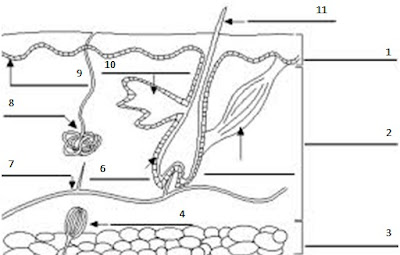Exercises
Figure 1 show the structure of the
human eye.
Figure 1
a)
Label the
structure of the eye with the following words:
· retina
· lens
· blind spot
· yellow spot
· pupil
· iris
· retina
· lens
· blind spot
· yellow spot
· pupil
· iris
b)
State the
function of
· cornea
· ciliary muscles
· aqueous humour
· sclera
· cornea
· ciliary muscles
· aqueous humour
· sclera
c)
What is a blind
spot?
Figure 2 shows
the cross-section of the human ear.
Figure 2
a)
Label the
structure of the ear:
1. ______________________
2. ______________________
3. ______________________
4. ______________________
5. ______________________
6. ______________________
1. ______________________
2. ______________________
3. ______________________
4. ______________________
5. ______________________
6. ______________________
b)
State the
function of the
·
semicircular
canals
·
Eustachian tube
·
cochlea
|
|
Figure 3 shows
the structure of the human skin.
Figure 3
a)
Label the
structure of the ear:
1. ______________________
2. ______________________
3. ______________________
4. ______________________
5. ______________________
6. ______________________
7. ______________________
8. ______________________
9. ______________________
10. ______________________
11. ______________________
1. ______________________
2. ______________________
3. ______________________
4. ______________________
5. ______________________
6. ______________________
7. ______________________
8. ______________________
9. ______________________
10. ______________________
11. ______________________
*Remember to try first before you refer to the notes given.
Check your answer from the notes given in front.






















